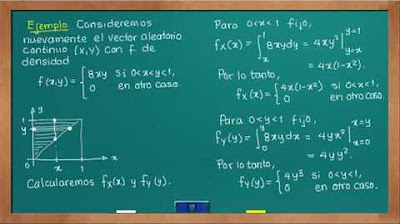Peluang ~ Menentukan Nilai Peluang dan Frekuensi Harapan Suatu Kejadian (Materi PJJ Klas VIII/8 SMP)
Summary
TLDRThis video explains fundamental concepts of probability and frequency expectation. It covers the definition of probability, how to calculate it for different events, and the concept of complementary events. Through examples like rolling dice, tossing coins, and exam probabilities, viewers learn how to calculate the likelihood of various outcomes. The video also delves into frequency expectation, illustrating how to predict the number of times an event will occur in multiple trials. By understanding these concepts, viewers can better approach problems involving probability and expected outcomes in real-world scenarios.
Takeaways
- 😀 Probability is a number between 0 and 1 that indicates the likelihood of an event happening.
- 😀 A probability of 0 means the event is impossible, while a probability of 1 means the event is certain.
- 😀 Complementary events: The sum of the probability of an event and its complement equals 1.
- 😀 Example: When rolling two dice, the probability of the first die showing a 3 is 1/6, based on 36 possible outcomes.
- 😀 Example: When tossing three coins, the probability of getting exactly two heads is 3/8, as there are 8 possible outcomes.
- 😀 The probability of failing an exam is the complement of the probability of passing, e.g., 1 - 0.85 = 0.15.
- 😀 Frequency expectation calculates how often an event is expected to happen based on its probability and the number of trials.
- 😀 Example: If three coins are tossed 80 times, the expected frequency of all heads is 10 times (80 × 1/8).
- 😀 Example: If a factory produces 1,000 items with a 5% defect rate, the expected number of non-defective items is 950.
- 😀 The formula for frequency expectation is the number of trials (N) multiplied by the probability of the event.
- 😀 Understanding probability and frequency expectation helps in making predictions about various real-world events, like dice rolls, coin tosses, and product quality.
Q & A
What is the definition of probability in this context?
-Probability is a numerical value that shows the likelihood of an event happening. It ranges from 0 to 1, where 0 means impossible and 1 means certain.
What does a probability value of 0 represent?
-A probability of 0 represents an event that is impossible, meaning the event will not occur.
What does a probability value of 1 signify?
-A probability of 1 signifies an event that is certain to happen, meaning it is guaranteed to occur.
What is the complement of an event, and how is it related to the event's probability?
-The complement of an event is the event where the original event does not occur. The sum of the probabilities of an event and its complement is always 1.
If the probability of rain today is 0.4, what is the probability of no rain?
-The probability of no rain is 0.6, since 1 - 0.4 = 0.6.
In the case of rolling two dice, how do you calculate the probability of the first die showing a 3?
-The sample space (total possible outcomes) for rolling two dice is 36. The favorable outcomes where the first die shows a 3 are: (3,1), (3,2), (3,3), (3,4), (3,5), (3,6), which gives 6 favorable outcomes. Therefore, the probability is 6/36, which simplifies to 1/6.
How do you calculate the probability of getting two heads when tossing three coins?
-The sample space for tossing three coins is 8. The favorable outcomes for getting exactly two heads are: (HHT), (HTH), and (THH), so there are 3 favorable outcomes. Therefore, the probability is 3/8.
What is the formula for calculating the expected frequency of an event in probability?
-The expected frequency (or expected number of occurrences) is calculated by multiplying the total number of trials (n) by the probability of the event (P). The formula is: Expected Frequency = n * P.
If you flip three coins 80 times, what is the expected number of times all three coins will land heads?
-The probability of all three coins landing heads is 1/8, as there is only one favorable outcome (HHH) out of 8 possible outcomes. Therefore, the expected frequency is 80 * 1/8 = 10 times.
How do you calculate the expected number of defective products if a company produces 1000 items with a defect probability of 0.05?
-The probability of a product not being defective is 1 - 0.05 = 0.95. The expected number of non-defective products is 1000 * 0.95 = 950.
Outlines

This section is available to paid users only. Please upgrade to access this part.
Upgrade NowMindmap

This section is available to paid users only. Please upgrade to access this part.
Upgrade NowKeywords

This section is available to paid users only. Please upgrade to access this part.
Upgrade NowHighlights

This section is available to paid users only. Please upgrade to access this part.
Upgrade NowTranscripts

This section is available to paid users only. Please upgrade to access this part.
Upgrade Now5.0 / 5 (0 votes)





